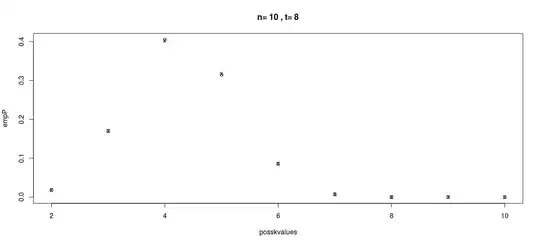Let $Y:=X_1+\ldots+X_n$. Observe that the distribution of $(X_1,\ldots,X_n)$ conditional on $Y = t$ is multinomial (exercise). This gives a conceptually easier way to think about the problem- you have $n$ boxes and throw $t$ balls in them at random. What is the probability that $k$ are empty?
Well, first of all, there are $n^t$ ways of throwing the $t$ balls in the $n$ boxes with no restrictions.
Now it gets a little more complicated, even though we are just counting stuff. There are $\binom{n}{k}$ ways of choosing the $k$ boxes that stay empty. We are then left with $t$ balls to throw into the $n-k$ remaining boxes, such that each box is not empty. You can do this by inclusion/exclusion, just like in the proof of the Stirling number https://math.stackexchange.com/questions/550256/stirling-numbers-of-second-type .
Combining these ingredients gives the desired probability,
$$
\frac{1}{n^t}\binom{n}{k}\sum_{j=0}^{n-k} (-1)^{n-k-j} \binom{n-k}{j} j^t,
$$
$t \ge n-k$, $n \ge k$.
Note that $\lambda$ does not feature in the answer.
Out of interest and as a quick exercise I coded this (borrowing a Stirling number function I found with Google) to see what the answer looks like:
##-- Stirling numbers of the 2nd kind
##-- (Abramowitz/Stegun: 24,1,4 (p. 824-5 ; Table 24.4, p.835)
##> S^{(m)}_n = number of ways of partitioning a set of $n$ elements into $m$
##> non-empty subsets
Stirling2 <- function(n,m)
{
## Purpose: Stirling Numbers of the 2-nd kind
## S^{(m)}_n = number of ways of partitioning a set of
## $n$ elements into $m$ non-empty subsets
## Author: Martin Maechler, Date: May 28 1992, 23:42
## ----------------------------------------------------------------
## Abramowitz/Stegun: 24,1,4 (p. 824-5 ; Table 24.4, p.835)
## Closed Form : p.824 "C."
## ----------------------------------------------------------------
if (0 > m || m > n) stop("'m' must be in 0..n !")
k <- 0:m
sig <- rep(c(1,-1)*(-1)^m, length= m+1)# 1 for m=0; -1 1 (m=1)
## The following gives rounding errors for (25,5) :
## r <- sum( sig * k^n /(gamma(k+1)*gamma(m+1-k)) )
ga <- gamma(k+1)
round(sum( sig * k^n /(ga * rev(ga))))
}
pmf<-function(n,t,k) {
if (t >= (n-k) & n >= k) {
(choose(n,k) * factorial(n-k) * Stirling2(t,n-k) )/(n^t)
} else {
0
}
}
lambda <- 1
n <- 10
reps <- 500000
set.seed(2017)
X <- matrix(ncol=n,nrow=reps,data=rpois(n*reps,lambda))
K <- apply(X, 1,function(x){sum(x == 0)})
hist(K)
# restrict only to those that sum to t
Y<-rowSums(X)
t<-8
G<- (Y == t)
sum(G)
k <- 5
#head(X[which(K==k),])
#head(Y[which(K==k)])
#head(X[G,])
#head(Y[G])
posskvalues <- (n-t):n
nk <- length(posskvalues)
empP <- numeric(nk)
thP <- numeric(nk)
for(i in 1:nk) {
k <- posskvalues[i]
# sum(K[G] == k)
empP[i] <- sum(K[G] == k)/sum(G)
thP[i] <- pmf(n,t,k)
}
plot(posskvalues,empP,main=paste("n=",n,", t=",t))
points(posskvalues,thP,pch="x")

